Skeletons change their closet
On Tuesday, 14 employees and students moved carefully packaged skeletons and bones from 219 Science II to their new home in the Bessey Hall addition. The assortment, used for human anatomy classes, included real skeletons and bones acquired when the school was called Iowa State College (pre-1959). Mary Madsen, a teaching lab coordinator in genetics, development and cell biology, organized the transition to the new lab space in Bessey.
"I thought it respectful and necessary to hand carry these items over to the new labs," she said.
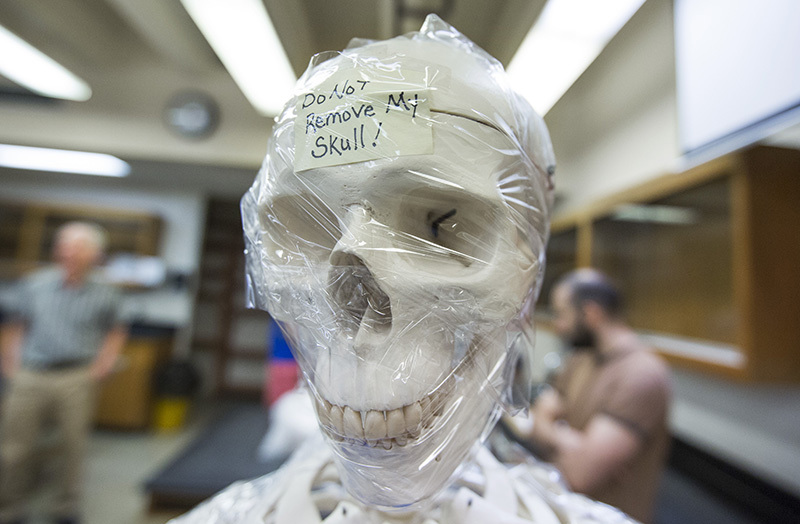
The skeletons and bones were carefully packaged before being removed from Science II. Photos by Christopher Gannon.
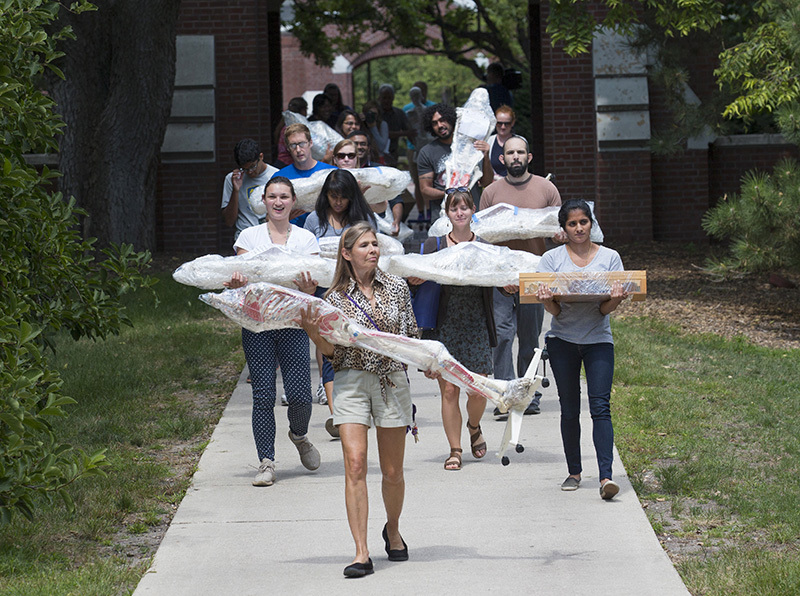
A parade of people, led by teaching lab coordinator Mary Madsen, carry 12 skeletons and two boxes of bones through the Lagomarcino courtyard on their journey from Science II to Bessey Hall.
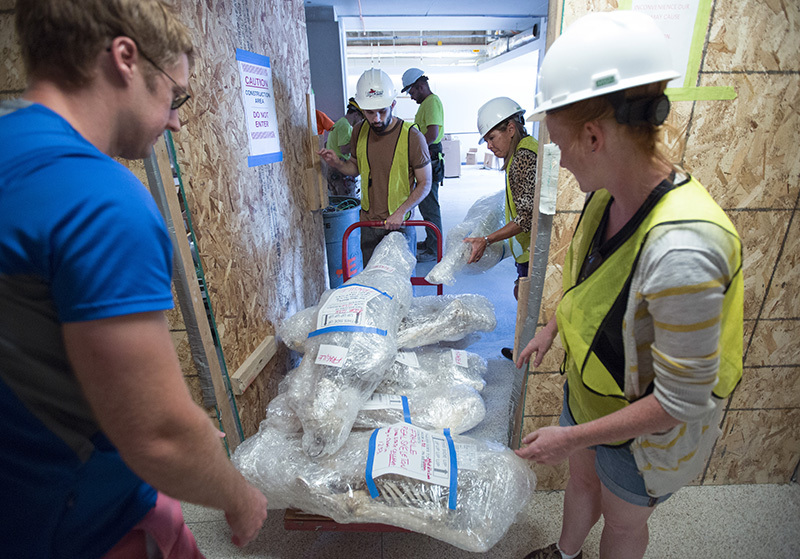
The skeletons and bones were delivered to the new Bessey Hall lab space, which still is under construction.
Seven percent tuition increases needed to catch up with decade of growth
Interim President Ben Allen told a regents task force Aug. 9 it would take annual tuition increases for five years of 7 percent for resident undergraduates and 4 percent for nonresidents to maintain quality and scale key aspects of the university to begin to catch up with 10 years of enrollment growth.
If enacted, those increases would raise base tuition to $10,457 in fall 2022 for resident undergraduates, to $25,905 for nonresident undergraduates. Base tuition for those students this fall is $7,456 and $21,292, respectively.
The state Board of Regents' tuition task force asked each of the three regent universities to prepare a five-year tuition proposal that supports its specific needs as part of a summer-long study aimed at making tuition rates more predictable. Northern Iowa shared its plan Aug. 7; Iowa presents its proposal Aug. 14.
Regent and tuition task force chair Larry McKibben, in opening the session, noted that "state funding is not adequately supplementing the lower tuition rates that our resident students deserve. First-generation families can't afford to send their children to our public universities."
McKibben continued that "It's unrealistic to expect three large universities to operate without annual revenue increases. It's time for the budgeting process to become proactive, not reactive."
Slides (PDF) from interim President Ben Allen's presentation
Bottom line
Allen shared this "bottom line" with the task force: Since 2009, Iowa State's enrollment has surged 37 percent while its state appropriation per resident student has dropped 30 percent. Iowa State is receiving $3,700 less per resident student from the state "while we're working to provide a high-quality education for more than 36,600 students -- about 55 percent of whom are Iowans.
"Over the past decade, we've been forced to stretch our faculty, staff and facilities -- and we've reached a breaking point," he said. "We’re tipping the balance between efficiency and educational quality."
Additional revenue, he said, would address four essential priorities that will protect and improve the quality of the student experience at Iowa State. Those priorities are:
- Faculty and staff retention. Provide competitive salaries and reasonable annual salary increases to ensure the university retains its top employees so students learn and are supported by the very best. Without new investments, the university will wipe out the progress it has achieved, Allen said.
- Faculty and staff recruitment. Hire enough faculty to achieve a net increase of 330 tenured and tenure-eligible faculty, two-thirds of whom would be in the STEM (Science, technology, engineering, math) disciplines. Without a major change in enrollment, this would lower the university's student-faculty ratio to 16:1. Additional staff are also needed, he said, to support the needs associated with a larger student body.
- Building maintenance and expanded capacity. An estimated 900,000 square feet of new building space is needed to accommodate the additional faculty and staff. The university also needs to address deferred maintenance issues, including the heavily trafficked STEM buildings.
- Investments in need-based financial aid proportional to the tuition increases. Iowa State's land-grant mission is to educate anyone eligible -- regardless of socio-economic status. Providing financial aid is an important part of that mission, Allen noted.
Five years: Iowa State undergraduate tuition proposal
|
Undergraduates |
Fall 2018 |
Fall 2019 |
Fall 2020 |
Fall 2021 |
Fall 2022 |
|
Resident |
|
|
|
|
|
|
7% increase |
$522 |
$558 |
$598 |
$639 |
$684 |
|
Base tuition |
$7,978 |
$8,536 |
$9,134 |
$9,773 |
$10,457 |
|
Nonresident |
|
|
|
|
|
|
4% increase |
$852 |
$886 |
$921 |
$958 |
$996 |
|
Base tuition |
$22,144 |
$23,030 |
$23,951 |
$24,909 |
$25,905 |
Fall 2017 tuition: Resident $7,456, nonresident $21,292
Iowa State's tuition proposal is built upon four assumptions over the next five years, Allen told the task force. If any of them change, the proposal would be revisited. They are:
- Flat state operating appropriations.
- Flat enrollment.
- Inflation of 2.14 percent (five-year average of the Higher Education Price Index).
- Annual reallocations in the university operating budget of 2.25 percent, "our commitment to our students and Iowa taxpayers," he said.
Allen also said university leaders and friends will continue to advocate strongly to the Legislature to provide more operating funds.
"Our students deserve it, and frankly, our state needs it," Allen said, citing a state workforce report that 128,000 Iowans aged 25-64 years will need to earn a degree or gain other credentials to be employable in 2025.
Tipping the balance
Allen gave examples of leading indicators that Iowa State has arrived at its breaking point. He said faculty in the colleges of Business and Engineering and staff in student counseling services have left due to salary issues. More faculty and staff could have left but have stayed out of loyalty, he said. He also cited an ag education teaching classroom with a capacity of 30 now holding 70 students. Ten engineering teaching labs run 12 hours a day and two large lecture halls (Kildee and Food Sciences) are in "desperate need" of renovation, Allen said. College of Business classes run until 10 p.m. four nights a week due to classroom availability.
"It took us 10 years to reach this imbalance, and it likely will take us more than five years to correct it, but we must start now to fix the issues," he noted.
While the proposal focused on undergraduate tuition, graduation tuition will go up in step with undergraduate increases, Allen said. He also said differential tuitions would continue to be used to help pay the costs connected to academic programs that are more expensive to deliver.
Public input
Eleven people, including five Iowa State students and three state legislators, spoke during a 60-minute listening session that followed the Iowa State presentation. Two business leaders from the ISU Research Park (and ISU alumni), vice president Dave Tucker of Workiva and site manager Mike Roof of Boehringer Ingelheim, spoke about the importance of having Iowa State students as interns and employees.
"Iowa State is my primary recruiting pipeline," Tucker said. "We'll hire 30 to 50 percent of our interns, in part depending on how well I can compete with Google, Amazon and Microsoft for those students."
Fifty-three of this summer's 59 interns are Iowa State students and because of their skills, they are put on product development teams and many have written code that's in production before their internships are over.
"What is critical to me is that Iowa State is able to continue doing what it does to maintain that caliber of student," Tucker said. "I want students I have to compete for. They've done a good job of that so far."
Roof said Boehringer Ingelheim is in Ames for two reasons: technology and talent. He said 40 percent of the 75 Ames employees are Iowa State alumni. He also relies on Iowa State for undergraduate interns, graduate researchers and research agreements.
He said Iowa State grads come with knowledge and skills that give them "an exponential jumpstart as we integrate them into the company."
"Anything you do that impacts tuition and employment impacts us at the research park, and I would encourage anything you can do to keep tuition low," Roof said.
Noting that the state is not in an economic recession, Rep. Beth Wessel-Kroeschell told task force members, "I don't want you give up on legislative and state support. It's our responsibility to make sure young Iowans have access to an affordable education."
She said the job before them is to look at the current budget, find spots "where we are misspending dollars and revert those to areas that are our responsibility. One of those is higher education."
McKibben said the four-member task force will present its report to the full board at its September meeting.
Related story
Universities asked to prepare five-year tuition proposals for regents' tuition task force, July 20, 2017
Welcome
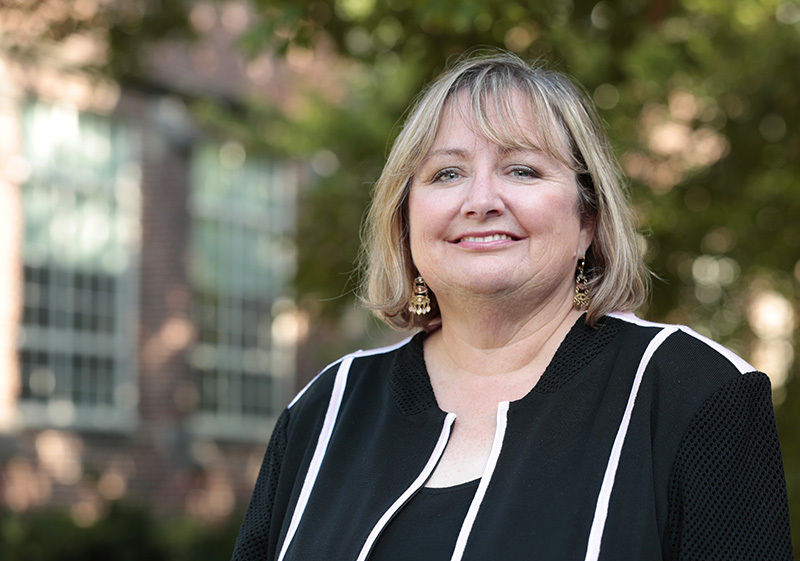
Photo by Christopher Gannon.
Deanna Clingan-Fischer started Aug. 7 as the university's first full-time ombuds officer.
In existence since 2008, the ombuds office is a confidential, neutral resource to assist employees with informally working through challenges in the workplace. It is an independent unit of the president’s office charged with providing service that is not biased towards any particular group.
Clingan-Fischer comes to Iowa State after serving for the last six years as the state's long-term care ombudsman. In that role, she directed investigations of consumer complaints related to health care facilities, assisted living programs, hospital long-term care units, elder group homes and Medicaid-managed care.
The ombuds office is in 37 Physics and services are available by appointment. Clingan-Fischer may be contacted by phone, 294-0268, or email, ombuds@iastate.edu.
Related story
Full-time ombuds officer starts Aug. 7, July 27, 2017
Classification review takes center stage at P&S Council
Next P&S Council meeting: Sept. 7 (2:10-4 p.m., Memorial Union Gallery)
Next P&S seminar: Sept. 12 (2 p.m., Memorial Union Pioneer Room), with Stephanie Downs, employee wellness coordinator.
The Professional and Scientific Council learned about the latest developments in the university's classification and compensation review for professional and scientific (P&S) staff and discussed and approved assisting university human resources (UHR) with logistical details for employee open forums about the review process.
Classification and compensation update
Ed Holland, UHR director of benefits, told the council at its Aug. 3 meeting that the job profile tool (JPT) P&S employees were asked to complete in June yielded a 76 percent completion rate.
"I thought that was really good, and we're happy with it," Holland said.
Now the review team is compiling the job collection tool information and examining feedback from administrators. Following that, Holland said, the team will devise a preliminary classification and compensation structure, determine uniform titles, and collect and evaluate benchmark and market data.
In response to a question from council about who will review and react to the new preliminary structure, Holland explained that two groups, to be assembled by mid-fall, will offer input to the review process. They are:
- Extended project team -- employees knowledgeable about campus and its employee structure
- Advisory committee -- staff who also will help communicate changes to the campus community
Council president Jessica Bell stated that P&S Council will have representation on both teams.
FAQ and feedback
Holland encouraged council members -- and their constituents -- to visit the classification and compensation review web page on the UHR website, especially the latest FAQ, which addresses questions about job titles, job families, pay changes and reporting relationships. He emphasized that anyone who has questions about the review process should complete the email form at the bottom of the FAQ page, which goes directly to classification and compensation staff. They will respond to the email and, if similar questions become frequent, add them to the FAQ.
"I know there are a lot of folks who have questions out there on this project," Holland said. "This is a website that's evolving, so check it from time to time because there will be additional things added."
Open forums
Bell said UHR requested the council's assistance with organizing three open forums for P&S employees about the classification and compensation review. The forums, proposed for September, October and November, would cover the project basics and provide opportunities for employees to ask questions. Each forum will cover the same information, but offer multiple opportunities for employees to attend.
Tera Lawson, chair of the professional development committee, said the committee is willing to host an October classification and compensation open forum as part of the council's seminar series.
Some members questioned how P&S Council would add value to the open forum process and if other seminar opportunities might be missed by accommodating UHR's request.
"I think this is our opportunity to help [UHR] tailor the information to our P&S employees who are directly affected by this," Lawson said. "Having it be a seminar series is a service to our constituents."
Katie Thorson, chair of the peer advocacy committee, reminded council members that strengthening its relationship with UHR is a priority.
"Building our relationship with UHR is one of our priorities, and I think this is a good first step toward that," Thorson said.
Following discussion, the council approved a motion to have the professional development, compensation and benefits, and peer advocacy committees work with UHR to organize the classification and compensation open forums.
In other news:
- Vice president for university community relations Teresa Albertson reported that UHR has streamlined the employee orientation process, which may likely change the P&S Council’s involvement in the orientation session. Albertson and UHR representatives are working together to maintain access to new P&S employees while also supporting the newly shortened orientation sessions. A suggestion offered by UHR is to have a council representative set up a table supplied with information about the organization and be available to new employees after the sessions. The council passed a motion to have the executive committee take up this issue.
- Lawson reported on behalf of the professional development committee that the next P&S professional development conference, "Cultivating Your Adventure," is slated for Feb. 14, 2018.
New building is core of research park's sunny outlook
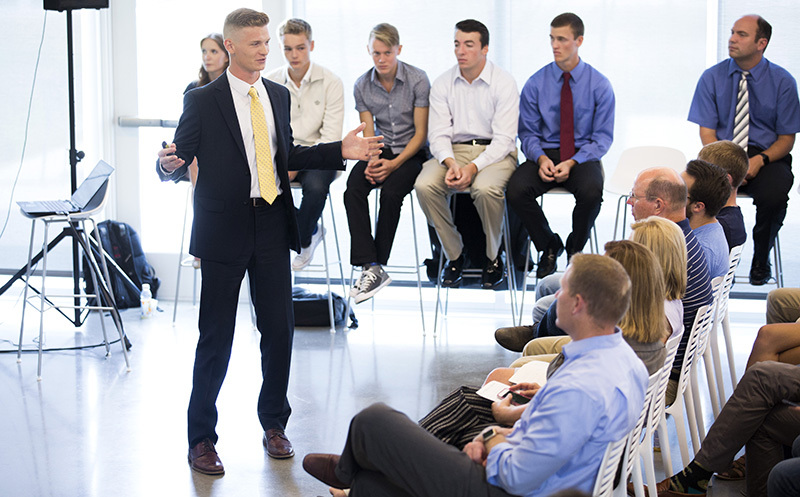
Recent Iowa State graduate Jake Oswald delivers a presentation on his business, Our Anthology, at the CyStarters finale event on July 28 at the Economic Development Core Facility. CyStarters, a startup accelerator, is one of the student programs housed at the building, which opened in 2016 to provide a home for the university's economic development agencies. Photo by Christopher Gannon.
As a dispersing crowd milled about in the atrium of the building that houses Iowa State's economic development agencies, Brian Tapp had an impromptu tip for Jake Oswald.
Oswald, a recent landscape architecture graduate, had just finished presenting the business idea he worked on this summer in CyStarters, Iowa State's 10-week student startup accelerator. The Osceola native, a member of one of 12 teams to outline their ideas for an audience that filled the communal space on the building's first floor, started the program with a plan that fizzled out. He pivoted instead to a traveling story-sharing notebook.
Tapp, regional director of the Small Business Development Center (SBDC) based out of the same building, suggested another tweak. Sell the same story-sharing concept, but in a corporate consultant context, as a bonding or ice-breaking exercise. After Tapp walked away, Oswald marveled at the casual morsel of mentoring.
"That's the third or fourth interaction I've had with that man in this square," Oswald said. "It's invaluable."
Productive chance encounters are meant to be routine at the Economic Development Core Facility, which opened last summer as the gleaming new nexus of the Iowa State University Research Park.
"That proximity, that constant interaction and opportunity for interaction, is where innovation springs from," said Mike Crum, vice president for economic development and business engagement.
At the same table
While digital collaboration has its benefits, clustering agencies with intersecting purposes is helpful for clients and makes staff more effective. Or as Judi Eyles, assistant director of the Pappajohn Center for Entrepreneurship, puts it: "There's just nothing better than sitting across the table."
The core facility collects under one roof the university's concerted efforts to help businesses form and blossom. "These units were all over the place," Crum said.
The Pappajohn Center, SBDC, Crum's office and the student-staffed CyBiz Lab were in research park buildings. The Center for Industrial Research and Service was in Howe Hall, while the Iowa State Research Foundation and the intellectual property and technology transfer office were in the former ISU Press office building on State Avenue. The core facility also gives an Ames home to the Cultivation Corridor, a public-private partnership focused on advances in agriculture and biosciences.
Putting all those offices in the same place means a client's meeting with one agency can turn into a consultation with another at a moment's notice, Crum said.
"Before, they had to make the connections themselves," he said. "Now, we're making those connections."
Recruiting tool
The impact of the $12 million facility, built with state money Iowa lawmakers approved in 2013, will stretch beyond its glass-and-whiteboard walls and custom-tailored collaborative spaces. As the first building in the research park's largely undeveloped 200-acre third phase, the core facility is designed to be the park's town square and a catalyst for commercial development sought by tenants – a health clinic, a restaurant, a fitness center and a child care center, for starters.
"I'm not sure I'd call them amenities any more. Necessities," Crum said.
The addition of such on-site services is a big reason why Steven Carter, the park's president, believes the complex is poised to attract more mature companies and grow to host 5,000 workers by 2025, triple the number employed there now.
"We have, to a degree by necessity, grown incrementally over the years and put ourselves in a position to accelerate that growth in the last three years," said Carter, who also is director of the Pappajohn Center. "Now we sit well-prepared to grow at a much more purposeful, faster rate."
The new building is valuable as a recruitment tool of sorts, a physical embodiment of the university's investment in economic growth, Carter said.
"Had we not had this central facility, which brings these university functions together in a place that can be utilized by the university and the companies and is now being surrounded by these other sorts of amenities, it wouldn't have been nearly so compelling. I think this facility has exceeded all our hopes and expectations about how key it is," Carter said.
Game-changer
For students who work in the building, the upgrade has been striking and surprising, Eyles said.
"We had no idea how great it would be to be in a space like this," she said.
In the summer, student entrepreneurs such as Oswald who win acceptance into the burgeoning CyStarters program work in the wing of the core facility also used by the CyBiz Lab. About 40 students work for CyBiz during the school year, along with a smaller group in the summer, tackling real-life projects for paying clients.
Before landing in their new home, CyBiz students were embarrassed to meet clients at their former office and had to hold staff meetings in the hallway because none of their rooms were large enough, Eyles said. The core facility has been "game-changing" for them, she said.
"We were in a place where nobody wandered through, ever," Eyles said. "There's just a level of culture that is completely different than it used to be."
But who the students share the space with is as important as the space itself, Oswald said.
"It is great to have it all in one place, but it also has to do with the spirit of the people here," he said.
Welcome back to fall semester
Inside offers this reminder of fall semester kickoff events for faculty and staff:
College events
Human Sciences: Breakfast and convocation, Aug. 17, 8-8:30 a.m. breakfast, 8:30 a.m. dean's address, Reiman Ballroom, ISU Alumni Center, RSVP requested
Business: Family picnic, Aug. 18, 5:30 p.m., Maple Shelter, Brookside Park, RSVP requested by Aug. 10
Design: Reception, Aug. 18, 6-8 p.m., College of Design atrium
Veterinary Medicine: Convocation, awards and three faculty medallion presentations, Aug. 30, 8-9 a.m., 2532 Vet Med, continental breakfast available at 7:15 a.m. in the Alumni Room
Liberal Arts and Sciences: Convocation, awards and introduction of new faculty and staff, Sept. 5, 3:30 p.m., Memorial Union Sun Room, reception follows
Engineering: Convocation and awards, Sept. 7, 3:10-4 p.m., Howe Hall auditorium, reception follows
Agriculture and Life Sciences: Convocation, applied research awards and a faculty medallion presentation, Sept. 12, 4:10 p.m., MU Sun Room, reception follows
University events
Annual address, interim President Ben Allen, Sept. 14, 6:30 p.m., MU Great Hall, reception follows
University faculty and staff awards ceremony, Sept. 25, 3:30 p.m., MU Great Hall, reception follows
